FTA (изд-во). Flexography: Principles And Practices. Vol.1-6
Подождите немного. Документ загружается.

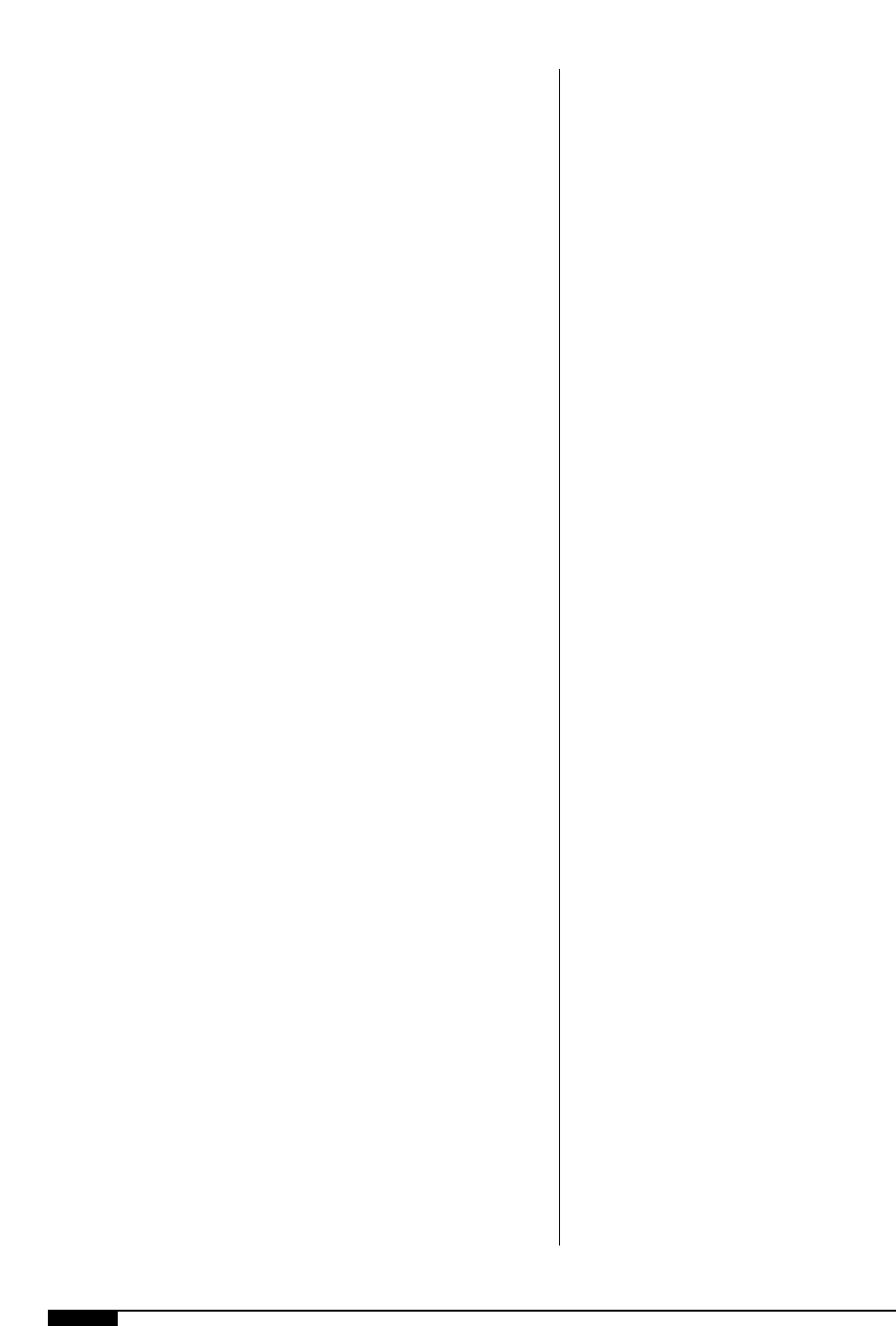
216 FLEXOGRAPHY: PRINCIPLES & PRACTICES
1. Double-check the ink to be added for
correct color. Do not assume that an
ink container is marked correctly.
2. Adjust pH and viscosity of the ink to
be added. Viscosity of water-based
inks should be five to 10 seconds high-
er than the ink in the fountain. Agita-
tion of the ink will cause a viscosity
drop of three to five seconds.
3. Add only enough ink to bring the level
back to the optimum level.
The optimum level should be determined
before the production run. It is based on the
amount of ink coverage for a given color,
which depends on the ink coverage for the
job being printed. The big print areas that use
more ink will require the ink pans to be filled
more often than those that use little ink. Add
fresh ink each hour to a low coverage area
rather than filling up the fountain and adding
only solvent or stabilizer for the whole shift.
Fresh ink helps maintain the correct balance
between colorant, resin, water and amine.
Ink loses printability and flow characteris-
tics if only water and amine are added over a
period of time. This loss is due to the deple-
tion of the colorant and the resin in the ink.
For the ink to work properly, and to avoid
printability problems, press operators must
know the following about the inks they are
using:
• upper and lower working viscosity
limits;
• solvents and additives to use;
• range of pH for water inks; and
• the maximum pigment load the ink
can handle.
By maintaining the proper percentages of
ink components, the color will be more con-
sistent and fewer print problems will occur.
Checking Quality
Conducting quality checks during a press-
run is an important part of the printing oper-
ation. Once a job is set up and running, cer-
tain steps must be followed in order to main-
tain quality throughout the run.
Color Consistency. Visual color checks of
printed samples should be done using a light
booth in the same manner as the color check
of the setup operation. More and more instru-
mentation is being used to verify color con-
sistency. Specific tools such as densitome-
ters, colorimeters and spectrophotometers
have replaced simple visual color checks.
A minimum of one sheet every 15 minutes
should be inspected during the pressrun for
any variation in color away from the color
standard. The sheet should also be inspect-
ed for other defects that would affect the
final product.
Samples should be compared throughout
the run to ensure that there are no color
drifts. A color drift occurs when the color
shifts in successive production samples.
Color drifts are checked by laying consecu-
tive samples on a white background in a
fanned out arrangement. One of the most
common causes of color drift is substrate
variation. Samples should be cut for com-
parison, rather than folded or overlapped, to
allow for more accurate comparisons.
Inspections and Quality Checks. During a
pressrun, the operator should make ongoing
inspections of the press and the job being
printed. The following items are typical
pressrun checks:
• Listen to the press for any unusual noises
that may indicate a mechanical problem.
• Double-check the ink level in the foun-
tain or pumping unit. When using a
pump, check the ink flow to the pan.
• Monitor print quality during the press-
run.
Inspecting a print sample is the most accu-
rate check of print quality. Operators should
not rely on checking print quality on the
moving sheet alone. Samples of the printed
product must be checked visually with the
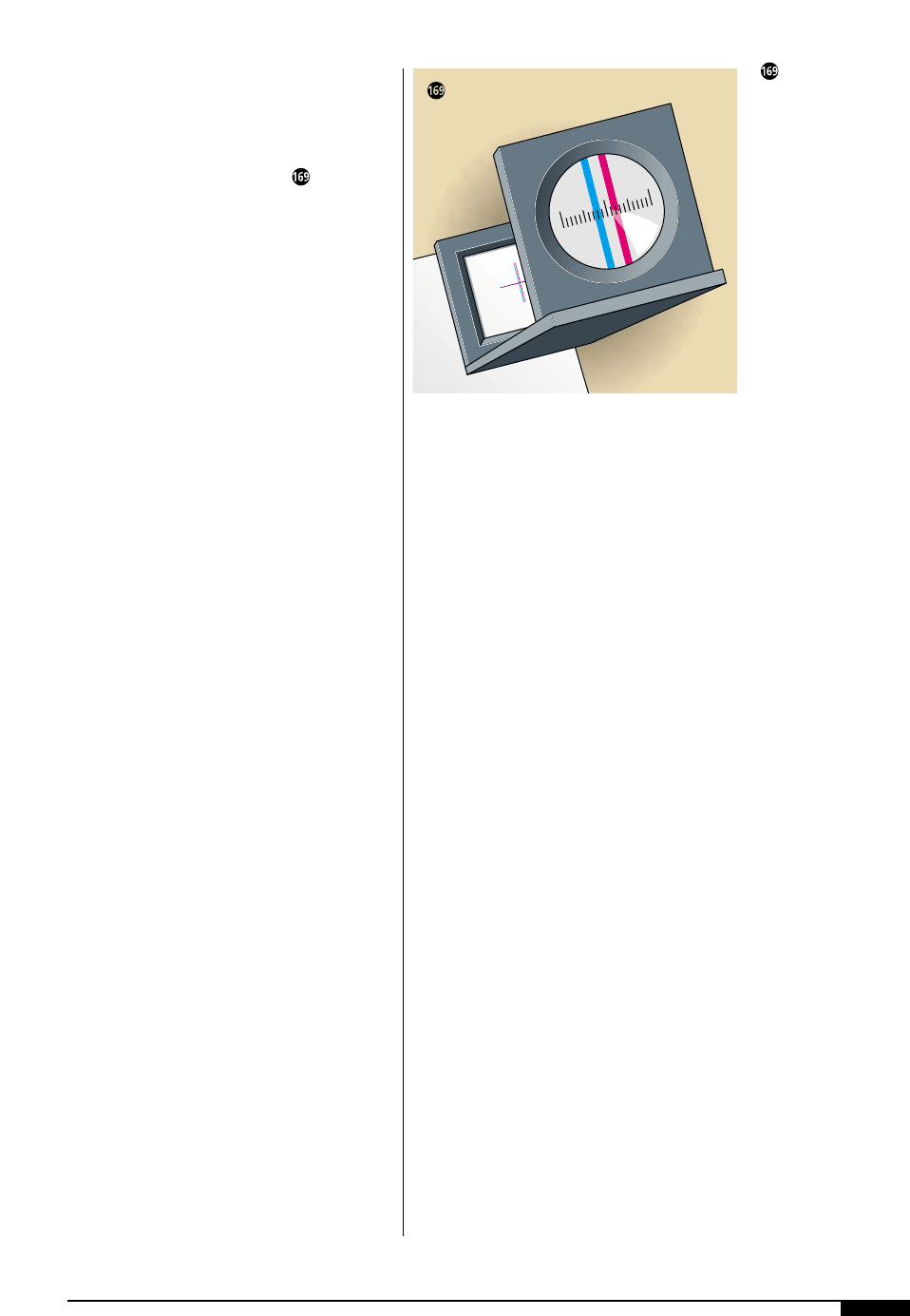
aid of a magnifier for poor registration, poor
ink lay, color drifts and color match.
During the inspection, the operator
should look for defects and variations in:
• print registration (Figure );
• cleanliness and sharpness of print;
• ink or impression misses;
• ink picking;
• flaws caused by plate lift, lint or other
causes;
• print quality;
• board defects;
• tracking;
• fill-in;
• excessive pressures; and
• print-to-cut registration.
General Housekeeping
When the press crew is not tending to other
duties, general housekeeping work is always
needed around the press. A conscientious
operator and crew ensures that the work area
is kept clean and in a workable condition.
The operator should also be conscientious
about maintaining the machine. Any irregu-
larities in the press such as strange noises, oil
leaks or other unusual signs may signal an
impending breakdown and should be investi-
gated immediately. The operator should
ensure that all lockout and tag-out proce-
dures are followed when housekeeping is
performed inside the press.
Production personnel should pay attention
during the pressrun to make sure that all con-
sumables are available in sufficient quanti-
ties. Stock and ink should be monitored in
order to keep a steady supply available. It is
important that the machine is not shut down
due to a lack of these items.
Other items such as ink additives, rags, load
tags, reports and machine logs should be mon-
itored and replaced before they run out.
Prepare for the Next Job
Operators should begin the setup for the
next job during the current pressrun. Work
completed in advance of the changeover
allows for a smoother and more efficient
setup. The operator should review the up-
coming job order and plan the best and
fastest way to change over to the next job.
Production personnel can find problems and
solve them before the next setup begins by
checking all the materials before the next set
up.
Stock for the next job should be located and
inspected to be certain it is the proper stock,
the correct size, and is in good condition. The
stock grade, test and flute should be inspected
to ensure that it is correct. Variations should
be reported before the set up begins.
The ink required for the next job should be
located and inspected to ensure that it is the
correct formula and available in sufficient
quantities. Color standards should be re-
viewed to help determine print station selec-
tion and anilox roll requirements.
Tooling and plates for the upcoming job
should be checked prior to the setup to make
sure the tooling is available and the plates are
in good condition.
CLEANUP PROCEDURES
Most jobs require some degree of cleanup
upon the completion of a run. Inks for the next
run are often different, which requires that the
PRESSROOM PRACTICES 217
A loupe, or magnifier,
will be of great
assistance in print
inspection.
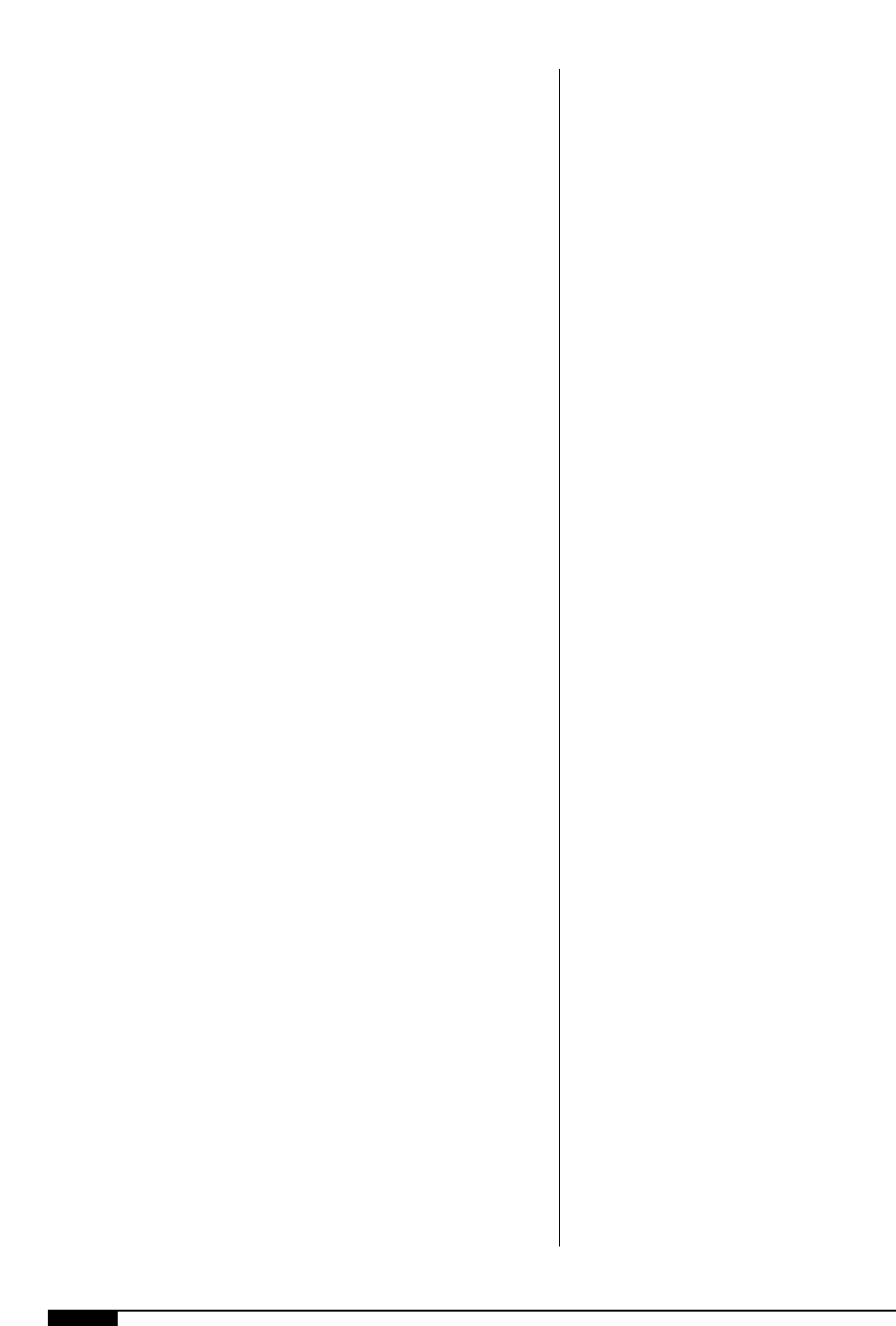
218 FLEXOGRAPHY: PRINCIPLES & PRACTICES
press equipment be washed. Since the press is
profitable only when it is in production, an
efficient cleanup program is needed. A correct
wash-up procedure minimizes downtime
between jobs and maintains the press in good
working condition. Cleanup procedures vary
by company and brand of equipment.
When a color change is required for the
next run, the old ink must be washed out of
the machine and replaced with fresh ink of
the new color. Depending upon the direction
of the color change (from light to dark or dark
to light), the time required to do the wash-up
will vary. Without a thorough wash-up, dark
colors will contaminate the lighter ink colors.
Printing plates should be cleaned and
rinsed after a production run and prior to
being placed in storage.
Cleaning Equipment and Materials
Operators should ensure that all needed
cleanup equipment and materials are at the
press before the press goes down for cleanup.
It is important for the ink to be cleaned up as
soon as possible after the machine goes down
so that the water-based ink is more soluble
and can be washed up with water and a high
pH soap. Dried water-based ink is very diffi-
cult to remove.
The follow cleaning equipment and supplies
should be on hand:
• warm water (120° F);
• rubber gloves ;
• eye protection;
• clean rags;
• cleaning solutions;
• brass brush for chrome anilox rolls;
• stainless-steel brush for ceramic anilox
rolls;
• soft-bristled brush for plates; and
• coating material (such as vegetable
shortening) for corrosion protection on
weekend cleanups.
Opening the Machine
Upon completion of the run, the press is
opened for cleanup. Company lockout or
tag-out procedures must be followed when
working inside the machine.
Conserve Ink
In an effort to conserve ink, the ink pan is
often lowered and the liquid ink squeegeed
down the ink-return hose and back into the
ink pump before a wash-up begins. The return
hose is then switched to the wash-up contain-
er or drain and the wash-up process begins.
Manual Cleanup
The following procedure details a typical
manual cleanup after the ink has been
drained from the pan. Company procedures
may vary depending on the specifications of
the machine.
1. Turn off the ink pump and disconnect
the power supply to stop the ink flow.
2. Pump cleaning solution through the
entire system. This pumping makes the
entire system easier to clean.
3. Remove the ink supply hose from the
deck.
4. Stop the rotation of the rubber roll.
5. Release the pressure between the rub-
ber roll and the anilox roll.
6. Move the ink-return hose from the ink
pump to the wash-up container.
7. Reset pressure between the anilox and
rubber roll and restart their rotation.
8. Flood the anilox and rubber rolls with
wash-up solution as they slowly turn.
The solution will remove ink from the
surface of the rolls. Several passes
over the rolls with fresh solution may
be needed to throughly remove the ink.
9. Release the pressure between the
anilox roll and rubber rolls on one end
only.
10. Wipe the anilox roll. Begin on the side
with the released pressure. Use a fold-
ed rag or shop towel soaked with
cleaning solution. If water-based ink is
being washed up, it is best to keep the
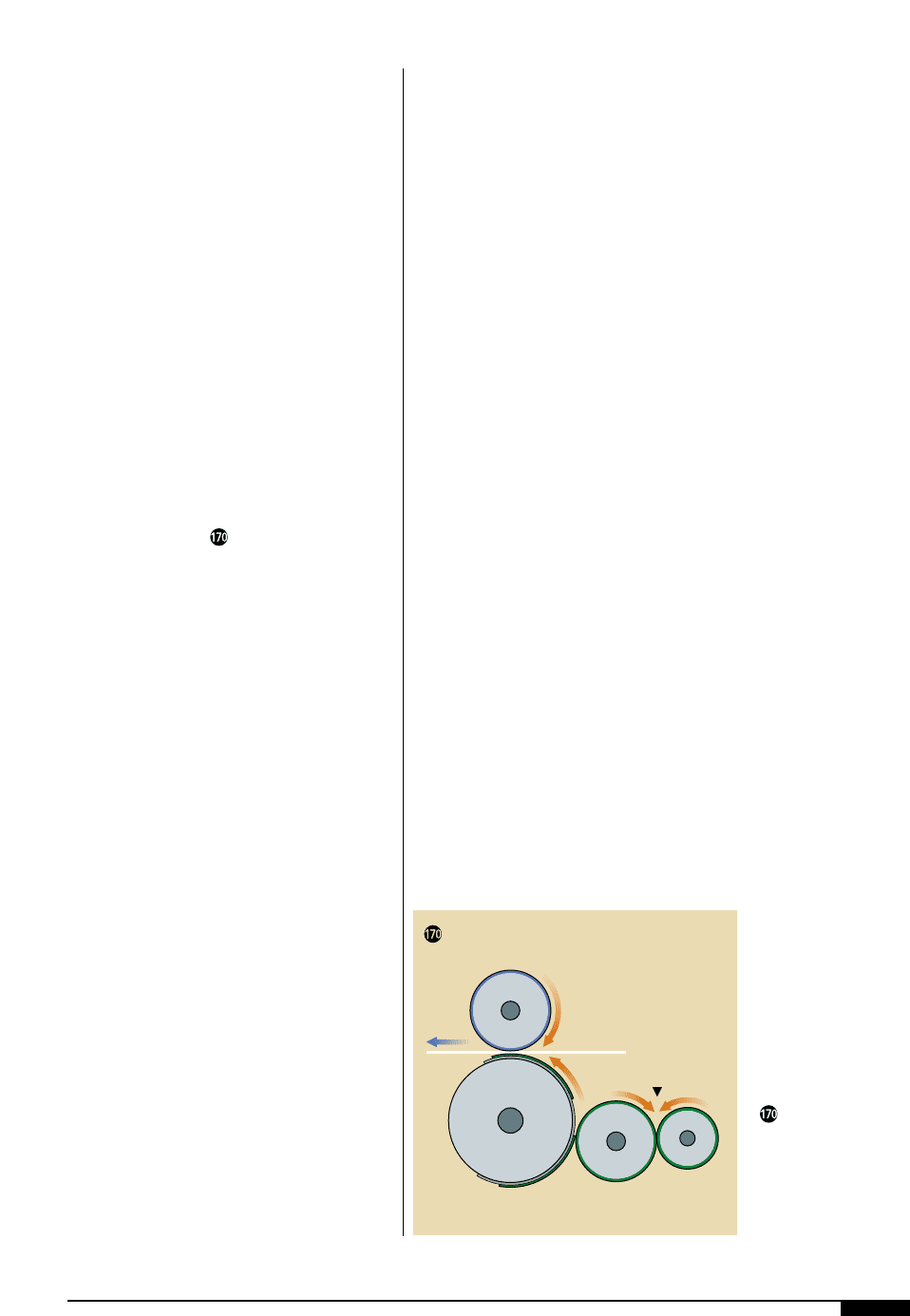
fountain roll and anilox roll wet until
the ink is washed off. It is very difficult
to clean off water-based ink after it has
dried on the rolls.
11. When the end of the roll is reached, re-
lease the pressure on the remaining
end. Finish wiping the anilox roll.
12. Clean the rubber roll the same way as
the anilox roll.
13. Stop the rotation of the rubber roll and
thoroughly clean both ends of the
anilox and rubber roll.
14. Go over each roll with clean, warm
water to remove any soap residue from
cleaning water-based ink. The print sta-
tion of a two-roll system contains pinch
points between various rolls. These
pinch points are referred to as inward
nips (Figure ). The person cleaning
the print station must use extreme care
in this area, because it is easy to catch a
rag or finger in the nip.
15. Remove and clean the ink filter.
16. Reassemble the station.
Cleaning the Plates
Clean the plates with cleanup soap and
water to remove any dried ink. The plate
should be scrubbed with a soft-bristled
brush and cleanup solution. It should then
be blotted dry with a rag. Rubbing the plate
with a shop towel should be avoided, as it
can damage the plate surface. After the plate
is cleaned, it may be removed from the plate
cylinder. The operator should make note of
any plate damage or defect so that new
plates may be prepared for upcoming runs.
Chamber-bladed Station Cleanup
The following procedure details a typical
cleanup of a chamber-bladed system:
1. Disengage doctor-blade assembly from
anilox.
2. Lock the blade assembly into the
cleanup position using the appropriate
safety mechanism.
3. Clean the anilox roll by passing a fold-
ed clean rag, soaked in cleanup solu-
tion, along the entire face of the rotat-
ing roll.
4. Scrub the anilox with a brush. Use
brass bristles for chrome rolls, steel
for ceramic rolls.
5. Turn off the anilox drive motor and
wash both ends of the anilox thor-
oughly.
6. Remove any ink buildup off the sides
of the anilox.
7. Make a final pass with a clean damp
rag, followed by a clean dry rag.
Extreme caution is required when cleaning
the anilox roll when a doctor blade is being
used. The cleanup person must be aware of
the location of the blade to avoid accidentally
bumping it while cleaning. Doctor blades are
extremely sharp and can cause severe injury.
Doctor-blade Assembly Cleanup
Cleaning the doctor-blade assembly re-
quires direct contact with the doctor blade.
Cut-resistant gloves should be worn to mini-
mize the risk of injury. In some cases, the
blade assembly is removed from the press for
cleanup. The following procedure details a
typical cleanup for a doctor-blade assembly:
1. Soak a shop rag or towel in cleaning
PRESSROOM PRACTICES 219
The area between
two rolls is known as
the inward nip. When
cleaning, one should
be careful not to catch
a rag or finger in this
area.
Impression
Cylinder
Sheet
Travel
Plate
Cylinder
Anilox
Roll
Wiper
Roll
Nip Roll
Danger Zone
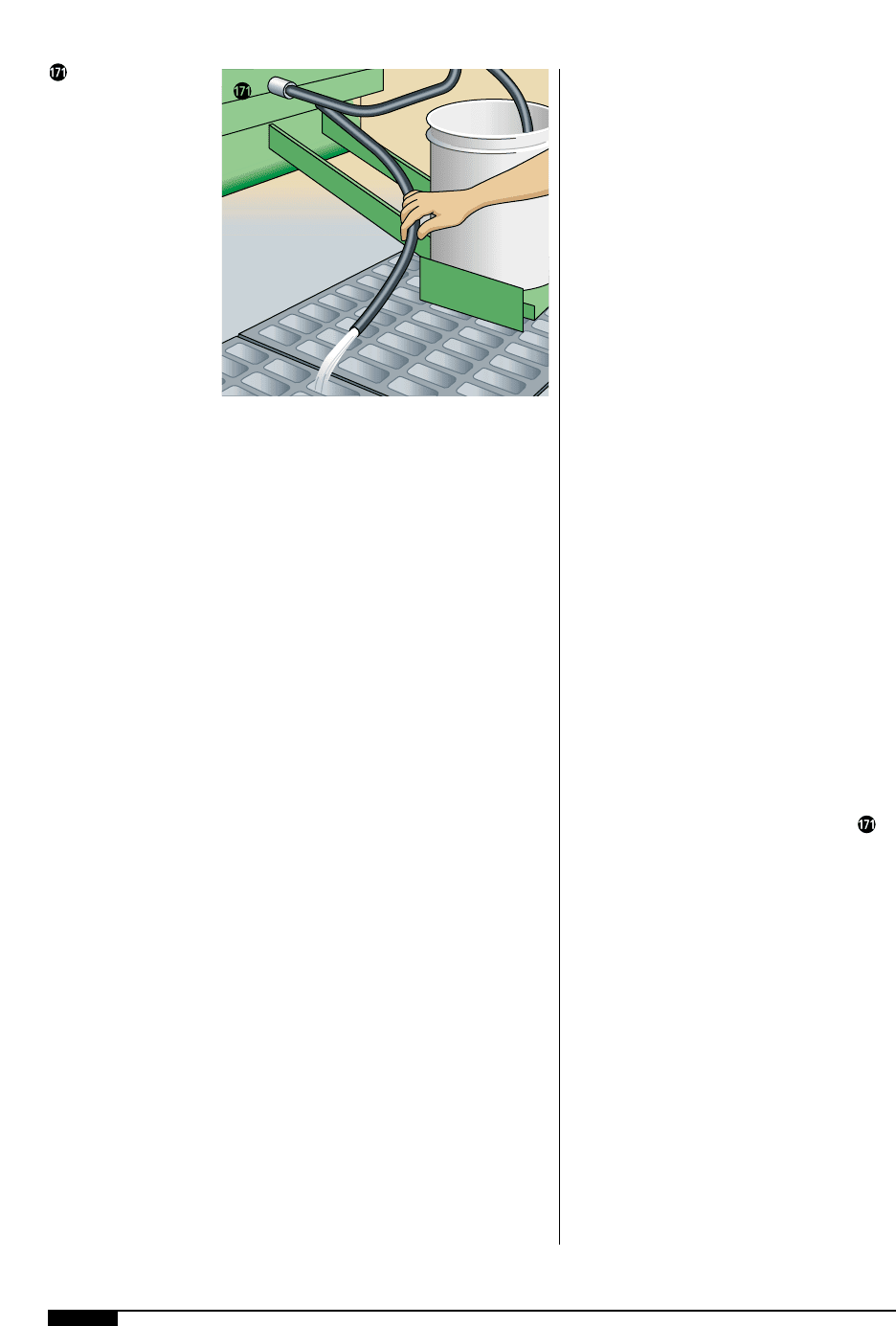
220 FLEXOGRAPHY: PRINCIPLES & PRACTICES
solution and wipe the inside and out-
side of the assembly. Also wipe both
sides of the blade. Light pressure will
reduce the chance of the blade cutting
through the rag.
2. Check the condition of the doctor
blade. Carefully remove blades that
show excessive wear or damage.
Properly dispose blades.
3. Continue cleaning the blade assembly
with a soaked rag until most of the ink
on the assembly is gone. Complete a
final pass with a clean damp rag to
remove any last traces of ink.
Ink Pan Cleanup
After washing the doctor-blade system, the
ink pan must be cleaned. The following pro-
cedure details a typical ink pan cleanup:
1. Put the pan into position for washing.
Scrape any liquid ink into the drain
hole.
2. Place a rag at the bottom of the ink pan
and saturate it with cleaning solution.
3. Pass the damp rag over the entire inte-
rior of the ink pan to rewet the dried
ink. Concentrate on areas where ink
buildup exists, rewetting the rag as
needed.
4. Wipe the ink pan dry using a second
rag when all ink buildup is removed.
Only a haze should remain.
5. Dampen another clean rag with clean-
ing solution to remove the remaining
pan haze. Immediately use a dry rag to
give it a final shine.
6. Use the two rags to clean the outside
of the pan and deck cover.
7. Remove the ink return hose. Wipe any
remaining ink out of the drain hole.
Automatic Wash-ups
Automatic wash-up systems are built into
some machines. They have a fixed sequence
of operations that are done automatically
for the operator. The system may be used
during setup, between orders, or at the end
of a run or shift.
When the automatic wash-up system is
engaged, the ink is automatically drained
from the system into the ink bucket and
saved for future use. After the ink is drained
from the inking system, the press operator
removes the ink bucket from the platform.
Water or clean-up solution is then automati-
cally circulated, and often pressure sprayed,
throughout the entire system.
Water and ink residue is then removed
from the inking system automatically. The
residue is dumped into the plate waste
drainage system for treatment (Figure ).
Automatic wash-up systems basically per-
form the same steps listed in the section
describing manual wash-up of the ink sta-
tion. It is important to remember that auto-
matic wash-up systems do not scrub the
anilox roll, and therefore, do not eliminate
this cleanup step.
Mark Ink Containers
The containers holding the ink used during
the run should be marked with the correct
ink color or number. Any additives, bases or
solvents that were added to the ink, and their
quantities, should be noted on the contain-
ers. Container labels are often covered by ink
spilling down the side of the bucket. If a spill
Ink residue from an
automatic wash-up
system should be
dumped into the plate
waste drainage system
for treatment.

PRESSROOM PRACTICES 221
occurs, attach a new label or identify the
bucket in some other manner.
Weekly Cleanups
In some situations, the press may not
require a complete wash-up because the col-
ors being run from job to job are similar and
contamination is not a major problem. In
this case, some of the press components are
only cleaned thoroughly on a weekly basis.
At least once a week, following the normal
wash-up, the anilox roll should be scrubbed
with a brush made for this purpose.
Operators should remember to use a brass
brush for chrome rolls and a stainless-steel
brush for ceramic coated rolls.
The ink pan under the rolls should be
cleaned weekly. In many cases, the ink pan
is not removable, so the cleanup must be
done around the rolls and doctor-blade
assembly. It is common to coat the inside
and outside of the pan with a thin layer of
material (one that is approved by the ink
company) to keep ink from drying on the
metal. Vegetable shortening is often used.
Other machine parts and components
should be cleaned. Keeping the press and
press area clean not only maintains the
appearance of the plant, but leads to a
safer work place and a better press perfor-
mance record.

PADHESION, INK
BINDING
BLEED
1. Under color drying too slowly or over
color drying too fast.
2. Poor physical property resistance.
1. Improve under color drying rate by
reducing viscosity and/or ink film
thickness. Use a faster or slower sol-
vent as required. Adjust or check
between station dryers. (Preceding
colors must be dry enough to receive
subsequent colors laid down.)
2. Use proper ink formulation and pig-
ment grade selection.
■ An under color wet-
ting into an over
color in a trapping
or overprinting
application.
■ Diffused or migrat-
ing colors in a
dried/cured ink film.
1. Irregular web tensioning, substrate
moving independent of plate move-
ment.
2. Gear bottoming off pitch line.
3. Intermittent plate slur.
4. Excessive ink viscosity.
5. Noncompressible stickyback.
6. Low durometer plate materials.
1. Reduce web tension. Clean and lubri-
cate driven and undriven rollers.
Check web tensioning mechanisms
for proper operation.
2. See defect “Gear Marks.”
3. Run bearers.
4. Reduce ink viscosity.
5. Use cushioned stickyback.
6. Use higher durometer plate materials.
■ Intermittent dark
lines of varying
widths running in
the web direction of
printed image.
1. Improper ink
formulation/chemistry.
2. Insufficient heat and/or air volume in
main dryer.
3. Low treatment level of
substrate.
4. Excessively reduced ink viscosity,
binder destroyed.
5. Surface of substrate may be
contaminated.
6. Surface of substrate
may require special
application.
1. Check ink for correct type and grade
for substrate being run.
2. Increase heat and/or air volume in
main dryer.
3. Check surface of substrate for ade-
quate treatment level.
4. Restore and maintain ink viscosity at
optimum point.
5. Apply wash-coat prior to printing.
6. Apply primer prior to printing.
■ Ink fails to adhere
to substrate.
■ Fails tape test.
■ Fails crinkle test.
■ Fails rub test.
PRESSROOM PRACTICES 223
Appendix A
DEFECT/INDICATOR PROBABLE CAUSE CORRECTIVE ACTION
PRESSROOM TROUBLESHOOTING CHART

224 FLEXOGRAPHY: PRINCIPLES & PRACTICES
BLOCKING
BRITTLENESS
COLOR STRONG
COLOR VARIATIONS
COLOR WEAK
1. Excessive ink viscosity reduction.
2. Excess extender varnish.
3. Ink settled out.
4. Plugged anilox roll cells.
5. Incorrectly specified anilox roll.
6. Incorrectly specified fountain roll.
7. Tight setting of fountain roll nip.
8. Worn anilox roll.
1. Add fresh ink to restore viscosity.
2. Add pigment concentrate (toner).
3. Thoroughly mix ink in container
before adding to fountain.
4. Thoroughly clean anilox roll.
5. Select anilox roll with higher volume.
6. Select fountain roll with lower
durometer.
7. Decrease fountain roll nip pressure.
8. Replace/refurbish anilox roll.
■ Lacking color
strength and body.
1. Lack of viscosity and/or pH control.
2. Inconsistent press speeds.
3. Variation in ink batches.
4. Color contamination.
1. Maintain viscosity and/or pH control.
2. Maintain consistent press speed.
3. Mix adequate amount of ink.
4. Improve cleanup procedures.
■ Inconsistent color
throughout a press-
run.
1. Excessive ink viscosity.
2. Excessive pigment load.
3. Incorrectly specified anilox roll.
4. Incorrectly specified fountain roll.
5. Light setting of fountain roll nip.
6. Doctor blade incorrectly set.
1. Reduce ink viscosity.
2. Add extender.
3. Select anilox roll with lower cell vol-
ume.
4. Select fountain roll with higher
durometer.
5. Increase fountain roll nip pressure.
6. Adjust doctor blade to parallel with a
minimum pressure setting.
■ Excess ink transfer
to substrate.
■ Excess color
strength.
1. Excessive heat or UV exposure level
in drying/curing system causing a
release of moisture and plasticizer
from substrate or ink film.
1. Control web temperature. Reduce
heat and/or increase volume of air
through drying chamber. Reduce UV
lamp power.
■ Ink film/substrate
breaks or cracks
when flexed.
1. Improper ink drying.
2. Excessive pressure in rewind.
3. Excessive weight in stack.
4. Softening of pre-applied coatings.
5. Web rewound too warm.
6. Web rewound with excess surface
moisture.
1. See defect “Drying Too Slow.”
2. Reduce rewind tension.
3. Reduce stack height.
4. Use solvents that do not attack prior
coatings.
5. Reduce web temperature by chilling
within ±10° of room temperature or
reducing dryer temperature.
6. Avoid rewinding excess surface
moisture on web prior to rewind.
■ Undesired adhesion
between two
surfaces.
DEFECT/INDICATOR PROBABLE CAUSE CORRECTIVE ACTION
PRESSROOM TROUBLESHOOTING CHART
(CONT‘D)

PRESSROOM PRACTICES 225
CURING OF UV INK
BLOCKING
CURING OF, UV INK (INCIDENTAL)
DOT GAIN
1. Excessive ink volume.
2. Excessive plate thickness.
3. High density stickyback.
4. Low ink viscosity.
5. Excessive pressure settings.
6. Poor ink metering application.
7. Damaged or worn press components.
8. Dirt on impression and/or plate
cylinders.
1. Reduce anilox roll volume to a
minimum while maintaining color
requirements.
2. Use thinner plates.
3. Use cushioned stickyback.
4. Increase ink viscosity.
5. Reduce pressure settings to a mini-
mum.
6. Use bladed ink metering application.
7. Check and replace damaged or worn
gears, bearings or cylinders.
8. Clean impression and/or plate cylin-
ders.
■ An excessive
increase in the size
of a halftone dot
from film to the
printed image.
1. Direct exposure to sunlight.
2. Exposure to general lighting sources.
1. Eliminate direct sunlight exposure.
2. Use UV filter covers on general light-
ing sources directly over press.
■ Ink curing prior to
printing and UV
lamp exposure on
plates, rollers, etc.
1. Improper ink drying.
2. Excessive pressure in rewind.
3. Excessive weight in stack.
4. Softening of pre-applied coatings.
5. Web rewound too warm.
6. Web rewound with excess surface
moisture.
1. See defect “Drying Too Slow.”
2. Reduce rewind tension.
3. Reduce stack height.
4. Use solvents that do not attack prior
coatings.
5. Reduce web temperature by chilling
within ±10° of room temperature or
reducing dryer temperature.
6. Avoid rewinding excess surface
moisture on web prior to rewind.
■ Undesired adhesion
between two
surfaces.
1. Low lamp power setting.
2. Weak exposure bulbs.
3. Dirty lamp reflectors.
4. Lamp focus incorrect.
5. Excessive press speed.
6. Excessive ink film thickness.
7. Lamp shutter not opening.
1. Increase lamp power setting.
2. Replace exposure bulbs.
3. Clean lamp reflectors.
4. Adjust lamp focus to
optimal distance.
5. Reduce press speed.
6. Reduce ink film thickness.
7. Check lamp shutter
assembly operations.
■ Ink fails to cure.
■ Ink offsets in
rewound roll.
■ Ink picks on idle
rollers.
■ Ink tracks through
the press.
DEFECT/INDICATOR PROBABLE CAUSE CORRECTIVE ACTION
PRESSROOM TROUBLESHOOTING CHART
(CONT‘D)

226 FLEXOGRAPHY: PRINCIPLES & PRACTICES
DRYING TOO FAST
DRYING TOO SLOW
FEATHERING
1. Excessive pressure settings.
2. Incorrect solvent balance.
3. Uncontrolled ink viscosity and/or pH
range.
4. Improperly set ink metering applica-
tions.
5. Poor shoulder angles on plate.
6. Dust on the substrate transferring to
the plate.
7. Excessive static electricity present.
8. Dried ink on plates from startup or
previous run.
1. Use minimum pressure settings for
plate and anilox.
2. Use correct solvent balance.
3. Maintain proper ink viscosity and/or
pH range. Use fountain covers.
4. Readjust pressure settings of foun-
tain roll nip or doctor blade assembly.
5. Use a steeper shoulder angle on the
plate with consideration for support.
6. Use web cleaning devices when nec-
essary.
7. Use static eliminator bars.
8. Wash plates thoroughly after color
OK and when order is completed.
■ Irregular string-like
edges around print,
often on trailing
edges.
1. Use of slower drying solvents.
2. Ink viscosity too high.
3. Inadequate or unbalanced drying
equipment.
4. Improper ink formulation.
5. Excessive ink film thickness.
6. Pressroom environment consisting
of low temperature and/or high
humidity.
7. Excessive press speeds.
1. Use faster drying solvents.
2. Reduce ink viscosity. Check viscosity
approximately every 30 minutes.
3. Use adequate and balanced drying
system to accommodate normal
press speeds.
4. Use ink formulation having more
hold-out capability.
5. Reduce ink film thickness.
6. Control pressroom environment to
ideal conditions.
7. Reduce press speeds.
■ Ink fails to properly
dry.
■ Ink pick-off or
transfer to press
rollers and/or sub-
sequent plates.
■ Ink offsetting or
blocking in rewind
or stack.
■ Ink penetration of
paper.
■ Tacky print surface.
1. Improper use of solvents.
2. Low pH level.
3. Uncontrolled or unrestricted air
movement in the vicinity of plates
and rollers.
4. Failure to use fountain covers.
5. Improper ink formulation.
6. Excessive preheat web temperature
entering print stations.
7. Pressroom environment consisting
of high temperature and/or
low humidity.
1. Use proper solvents.
2. Check pH and adjust to optimum
point.
3. Eliminate excessive air movement in
vicinity of plates or rolls by fans,
open windows or doors. Balance air
intake and exhaust flow for between
station dryers.
4. Use fountain covers.
5. Use proper ink formulation for sub-
strate being printed.
6. Reduce preheat web temperature
entering print stations.
7. Control pressroom environment to
ideal conditions.
■ Ink drying on plates
and/or rollers and
failing to transfer.
DEFECT/INDICATOR PROBABLE CAUSE CORRECTIVE ACTION
PRESSROOM TROUBLESHOOTING CHART
(CONT‘D)
